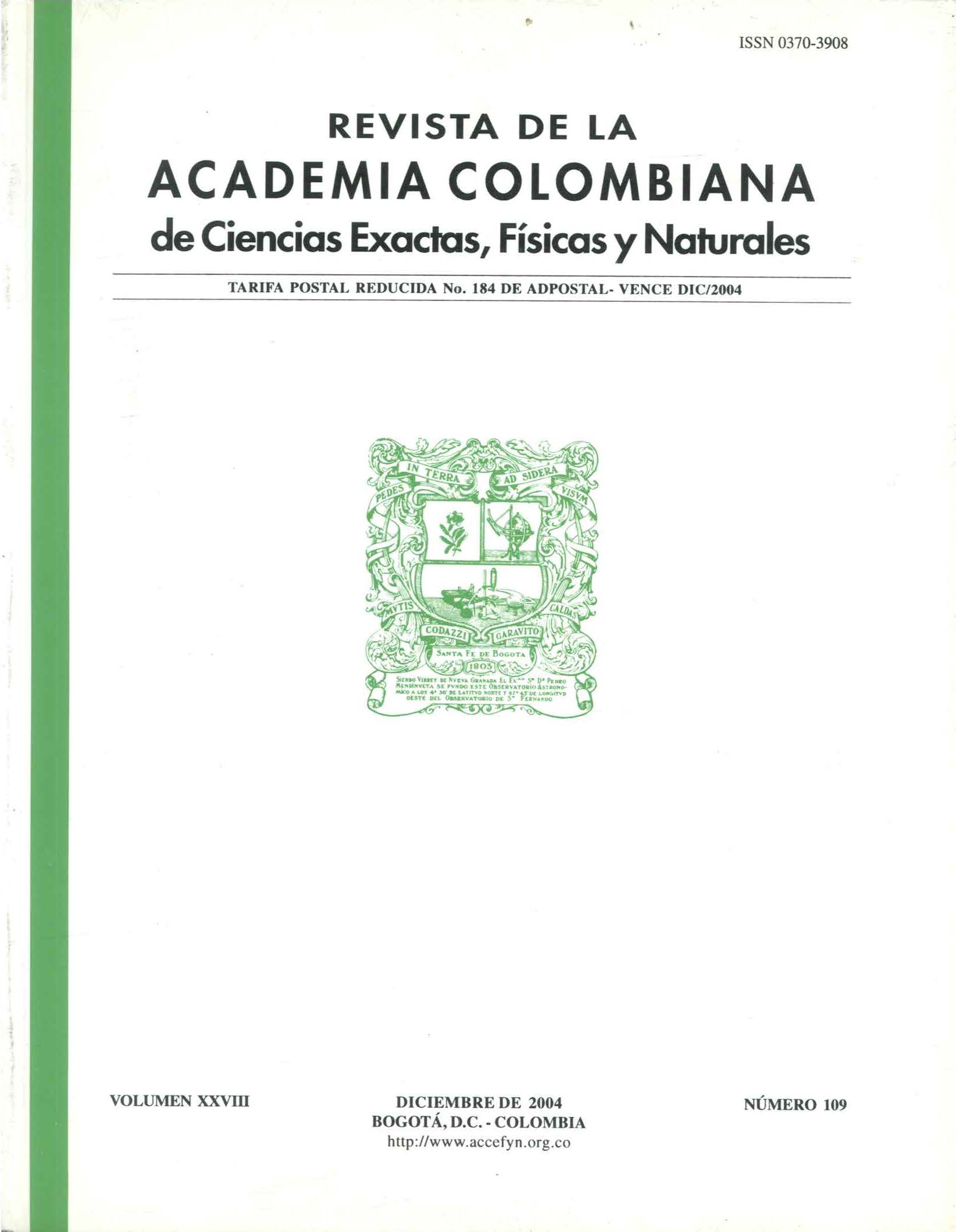Resumen
Se presenta una revisión taxonómica del género Galactia P. Br. para Cuba; se definen 24 taxones: 23 especies y una subespecie 16 de los cuales endémicos de la isla. Se discute su biogeografía a la luz de varias hipótesis biogeográficas, novedosos métodos de análisis molecular biogeográficos y el registro fósil de leguminosas. La diversidad taxonómica y el endemismo cubano de gran parte de las especies de Galactia, amerita un posterior análisis molecular biogeográfico del género junto con otros taxones estrechamente relacionados de la subtribu Diocleinae que permitan identificar los linajes Terciarios de leguminosas que han contribuido a esta diversidad.
Referencias
llen, C.N. & E.K. Allen 1981. The Leguminosae. A source book of characteristics, uses and nodulations. The University of Wisconsin Press, U.S.A. 812 p.
Andrade, I.F. 1981. Production and chemical composition of Tropical Forage Legumes grown on the cerrado. Rev. Soc. Braz. Zootec., 10(1):103-122.
Burkart, A. 1971. El género Galactia (Leguminosae-Phaseoleae) en Sudamérica con especial referencia a la Argentina y países vecinos. Darwiniana 16 (3-4): 663-793.
D’Arcy, W.G. 1980. Galactia. Annals of the Missouri Botanical Garden 67 (3): 699-702.}
Date, R.A. & J. Halliday. 1980. Relationships between Rhizobium and Tropical Forage Legumes. In: R.J. Summerfield & A.H.Bunting (ed.). Advance in Legume Science. Univ. of Reading England. 601 p.
Ferguson, I. & J. Skvarla. 1981. The pollen morphology of the subfamily Papilionoideae (Leguminosae). In: Polhill, R.M. & P.H. Raven (eds.) Advances in Legume Systematics, part. 2, Kew: Royal Botanic Gardens. pp. 859-896.
Goldblatt, P. 1981. Cytology and the phylogeny of the Leguminosae. In: Polhill, R.M. & P.H. Raven (eds.) Advances in Legume Systematic, part. 2, Kew: Royal Botanic Gardens. pp. 427-463.
Graham, A., D. Cozadd, A. Areces-Mallea & N.O. Frederiksen. 2000. Studies in Neotropical paleobotany. XIV. A palynoflora
from the middle Eocene Saramaguacán Formation of Cuba.
Am. J. Bot. 87: 1526-1539.
Herendeen, P.S., W.L. Crepet, & D.L. Dilcher. 1992. The fossil
history of the Leguminosae phylogenetic and biogeographic
implications. In: Herendeen, P.S. & D.L. Dilcher (eds.).
Advances in Legume Systematics, Part. 4, The fossil Record.
Kew: Royal Botanic Gardens. pp. 303-316.
Holmgren, P.K, N.H. Holmgren & L.C. Barnett, editors. 1990.
Index Herbariorum: Part. 1. The Herbaria of the World, 8th
ed. Regnum Vegetabile vol. 120. The New York Botanic Garden,
Bronx, New York. 693 pp.
Howard, R.A. 1988. Flora of the Lesser Antilles, Leeward and
Windward Islands. Arnoll Arboretum Harvard University. Vol.
Dicotyledoneae part I, Jamaica Plain, Massachusetts.
Instituto de Geografía ACC e Instituto Cubano de Geodesia y Car-
tografía. 1989. Nuevo Atlas Nacional de Cuba.
Lackey, A. 1981. Tribe 10. Phaseoleae, subtribe Diocleinae. In: Polhill,
R.M. & P.H. Raven (eds.) Advances in Legume Systematics,
part. 2, Kew: Royal Botanic Gardens. pp. 314-315.
Lavin, M. & M. Luckow. 1993. Orogins and relationships of Tropi-
cal North America in the context of the boreotropics hypothesis.
Amer. J. Bot. 80: 1-14.
Lavin, M. 1998. Origin, diversity, and biogeography of Neotropical
Fabaceae. Monogr. Syst. Bot. Missouri Bot. Gard. 68: 131-135.
Lavin, M., M.F. Wojciechowski, A. Richman, J. Rotella, M.J. San-
derson, & A. Beyra-Matos. 2001. Identifying Tertiary radia-
tions of Fabaceae in the Greater Antilles: Alternatives to cladistic
vicariance analysis. Int. J. Plant. Sci. 162 (6): 1-24.
Lavin, M., A. Beyra M., G. Lewis & L. Rico. 2002. Hotspot diversity
in the Caribbean: Museum or cradle. In Horvitz, Carol C.,
Organizer 2002 Symposium in Panama City, 29 July through
August, entitled “Islands in the storn”: biodiversity, natural
disturbance and conservation in the Caribbean “Sponsored by
the Coalition for Excellence in Tropical Biology”.
Liogier, A.H. 1974. Flora de Cuba Suplemento. Instituto Cubano del
Libro. La Habana. 81 p.
Myers, N., R.A. Mittermejer, C.G. Mittermejer, G.A.B. da Fonseca,
and J. Kent. 2000. Biodiversity hotspots for conservation
priorities. Nature 403: 853-858.
Pueppke, S.G. & W.J. Broughton. 1999. Rhizobium sp. strain NGR
and R. fredii USDA 257 share exceptionally broad, nested
host ranges. Molecular Plant-Microbe Interactions 12 (4): 293-
Rosen, D.E. 1976. A vicariance model of Caribbean Biogeography.
Syst. Zool. 24: 431-464.
Rosen, D.E. 1985. Geological hierarchies and biogeographic
congruence in the Caribbean. Ann. Missouri Bot. Gard. 72:
-659.
Sauget, J.S. & E.E. Liogier. 1951. Leguminosas. Flora de Cuba, vol.
Contr. Ocas. Mus. Hist. Nat. Colegio de La Salle. 10: 312-
Skerman, P.J. D.G. Cameron & F. Riveros. 1991. Leguminosas
Forrajeras Tropicales, Organización de las Naciones Unidas
para la Agricultura y la Alimentación. Roma. pp. 326-328.
Torres, Y., G. Agostini, & N. Xena de Enrech. 1983. Revisión
Taxonómica del género Galactia P. Br. en Venezuela
(Leguminosae, Faboideae, Phaseoleae). Acta Biol. Venez. 11
(4): 45-93.
UICN. 1994. Categorías de las Listas Rojas de la UICN (Unión Mun-
dial para la Naturaleza), Gland. Suiza 21 p.
Wheeler, E.A. 2001. Fossil dicotyledonous woods from the Florissant
Fossil Beds National Monument, Colorado In: E. Evanoff,
K.M. Gregory-Wodziki, KR Johnson, eds. Proceeding of the
Denver Meseum of Science and Industry, ser 4. Denver Museum
of Science and Industry, ser 4. Denver Museum of Science and
Industry, Denver. pp. 197-213.
Wheeler, E.A., & J. Landon. 1992. Late Eocene (Chadronian)
dicotyledonoud woods from Nebaska: evolutionary and
ecological significance. Rev. Paleobot. Palynol 74: 267-282.
Wiersema, J.H., J.H. Kirbride, Jr., & C.R. Gunn. 1990. Legume
(Fabaceae) Nomenclature in the USDA Germoplasm System.
U.S. Department of Agriculture, Technical Bulletin No. 1757,
p.

Esta obra está bajo una licencia internacional Creative Commons Atribución-NoComercial-SinDerivadas 4.0.
Derechos de autor 2023 Revista de la Academia Colombiana de Ciencias Exactas, Físicas y Naturales

